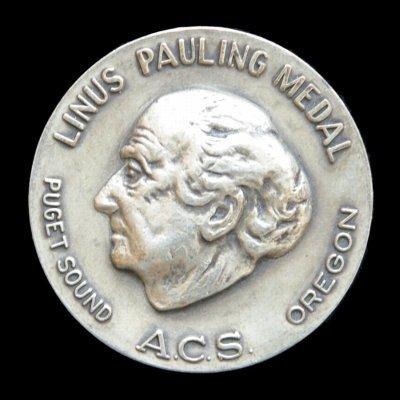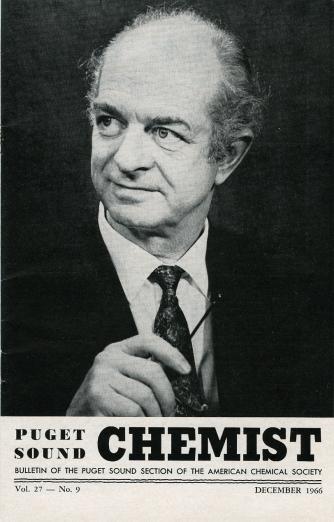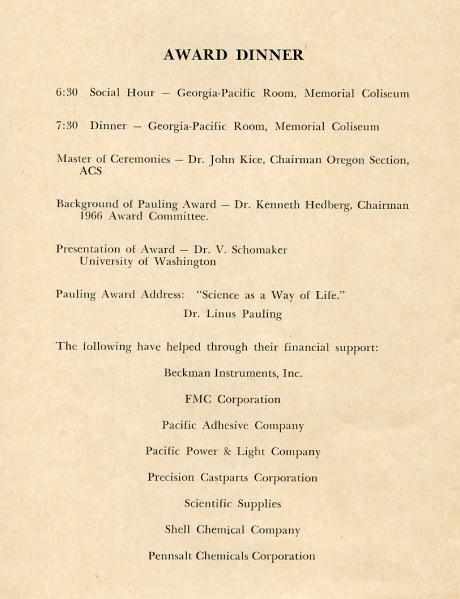
[Ed Note: With the awarding of the ninth Linus Pauling Legacy Award to Dr. Jane Lubchenco scheduled for next Tuesday, we thought this an appropriate time to take a look at the first award to have been named for Linus Pauling; one that turns fifty years old in 2016. This is part 1 of 2.]
Though Linus Pauling was a much celebrated and well-respected scientist across the globe, he traced his roots to the Pacific Northwest and always felt a special connection to the region. It would seem fitting then that the first award to bear his name would come from the area.
In a letter dated December 9, 1965, Pauling first learned that two regional sections of the American Chemical Society – the Puget Sound Section and the Oregon Section – were collaborating on a new award that would bear his name. The Linus Pauling Medal would be granted each year, beginning in 1966. Quite appropriately, the two sections asked that Pauling be the first recipient of the honor.
The Pauling Medal would replace the former Puget Sound Award (given, as one might assume, by the Puget Sound Section) and would “recognize distinguished achievement in chemistry.” Furthermore, though the interests of Pacific Northwest scientists would play a role in deciding who received the decoration, the nomination criteria made it clear that this was not specifically a regional award:
A nominee shall have made outstanding contributions to chemistry of a character that have merited national and international recognition and that are of particular interest to chemists of this geographical area.
Indeed, though two ACS sections sponsored the award, its nomination guidelines specified that recipients need not reside within the geographical regions represented by the two sponsors. And though the medal was named for him, Pauling did not think it proper for him to be involved with deliberations concerning recipients, and he accordingly refused to nominate anyone or offer a letter of endorsement for those nominated by others.
The award itself consists of a gold medal engraved with Pauling’s profile, crowned with the text “Linus Pauling Medal,” and also including the names of the (now three – the Portland ACS section joined the award in the 1980s) sponsoring ACS sections. The awardee’s name and the date that it is bestowed are engraved on the back of the medal, accompanied by the text “for outstanding achievement in chemistry.” The medal is accompanied by a scroll.
In its early years, the Pauling Medal was granted at a ceremony hosted alternately by the two sponsoring sections, with the Oregon section usually rotating its turns between venues at Oregon State University and the University of Oregon. The ceremony itself generally consisted of a meeting featuring a keynote address by the recipient and ancillary lectures as delivered by other distinguished chemists. The event concluded with a celebratory banquet. The ongoing costs of the award, including travel and meeting expenses, were split between the two sections.

By design, the nomination process established for the Pauling Medal had the potential to be long and complicated, involving several rounds of voting until a consensus was reached on one awardee. And from the beginning, the goal for each year has been to generate a minimum of ten nominations to be considered by the award committee, with a preferred pool of twenty possibilities.
Compiling this pool required the cooperation of both a canvasing committee and an award selection committee. The canvassing committee’s job was to solicit nominations, meet at the Northwest Regional meeting to review the names that had been received, organize them for evaluation by the award selection committee, and recommend any changes to procedure that might help out in the future. The call for nominations went out early in the calendar year, so as to allow for enough time to vet potential awardees and to find a ceremony date that was mutually agreeable.
At first, the canvassing committee expressed a preference for older candidates who, like Pauling, had remained creative and continued to make important advancements in their specific field. As the award developed and its standards became more concrete, the goal shifted to presenting the award to a chemist whose career would clearly benefit from the decoration, which usually meant concentrating on younger nominees (as was Pauling’s wish).
Once the canvassing group had done its job, the final selection was made by an award committee comprised of five members: two from each sponsoring section and a chair selected from alternating sections. In addition to the pool developed by the canvassing committee, the awarding group could add names of their own.
The criteria for selection were very flexible, with only two strict conditions placed: 1) no member of the canvassing or awarding committees could be considered and 2) a candidate could not be awarded the Pauling Medal for the same achievements that had led to their receipt of a Nobel Prize. Rather, consideration for the Pauling Medal would be based entirely on new and innovative work.

Linus Pauling received the first Linus Pauling Medal on December 3, 1966 at a celebration held in Portland’s Memorial Coliseum. His acceptance talk was titled “Science as a Way of Life,” and made mention of the insect collections that he compiled as a boy, a few scientific mishaps that he encountered during his career and, in particular, his struggles in determining the molecular structure of sodium dicadmide. He also included the now famous story of how he determined the alpha-helical structure of proteins while folding paper as he was sitting sick in bed.
In addition to Pauling’s lecture, the first Pauling Medal event included talks by Neil Bartlett, Martin Karplus, and Joseph Kraut. Bartlett would later receive the Pauling Medal himself in 1989 and Karplus – the 2013 Nobel Chemistry laureate – was likewise honored in 2004.
Having traveled to Oregon for the event, Linus and Ava Helen took advantage of their visit to drive down to Corvallis to meet with chemistry students and to speak as part of a convocation at Oregon State University. Following their time in Portland, they headed north to Spokane, Washington, where Linus gave a talk at Gonzaga University. From there they went to Seattle where they saw one of Ava Helen’s brothers and gave yet another lecture, this time at the University of Washington.
In the years that followed, the Paulings attended the Pauling Medal ceremonies as often as they could, participating more frequently as time went on. When Pauling was able to make it, he was recognized as a guest of honor of the sponsoring sections and would typically say a few words in praise of the awardee. In years when he was unable to attend the ceremony, Pauling would usually send a letter of congratulations to the awardee. He continued to attend the event long after Ava Helen’s death in 1981, making an appearance virtually every year until his own health started to decline in the early 1990s.
